Ibiza Villages
Visiting the 16 most beautiful villages on IbizaThere is something magical about the Ibiza villages that attracts visitors year after year and many of them end up establishing their second residence on the island.
People define them as white, quiet, bright, welcoming, many open to the sea and all inhabited by artists of all kinds such as painters, sculptors, writers, actors, etc., who show their art in the entertainment venues, streets, courtyards and squares.
From GOA Catamaran we have selected the 16 most beautiful Ibiza villages and we propose something new for private groups of families and friends, renting a boat for days and
“Visit Ibiza’s villages on a huge, fully equipped catamaran, a floating hotel with all the luxuries of comfort”.
Which Ibiza village are we visiting today?
- Es Cubells
- Sant Agustí d’es Vedra
- Sant Joan de Labritja
- Sant Carles de Peralta
- San Rafel de Sa Creu
- Sant Llorenç de Balafia
- Sant Josep de sa Talaia
- Santa Gertrudis de Fruitera
- Santa Agnès de Corona
- Sant Jordi de Ses Salines
- Sant Francesc de s’estany
- La Salinera
- Santa Eulària des Riu
- Sant Mateu d’Aubarca
- Sant Antoni de Portmany
- Sant Miquel de Balansat
Es Cubells
It is a village as small as charming, where undoubtedly what stands out most is its beautiful and particular church on the edge of a cliff which offers unique views of the south coast of the island.
The origins of the church date back to the 19th century, when the Carmelite exiled to Ibiza Francisco Palau, known as Pare Palau and famous for his solitary retreats in Es Vedrà, directed the chapel that would later become the church.
For boat lovers, know that on the cliff there is also a monument representing a llaüt, the traditional Ibicencan boat.

Sant Agustí d’es Vedra
This peaceful and quiet place, far from the main towns, is one of the best preserved villages on the island. The simple and beautiful architecture of its farmhouses surrounding the square make it a charming place. From the hill you can see the surrounding fields which makes a short visit very pleasant.
Peace and tranquility is what defines this Ibiza village.

Source: ibiza-spotlight.es
Location: See map
Highlights: Square with its country houses, the views from the hill.
Sant Joan de Labritja
It is the northernmost village of the whole island, and one of the least inhabited of Ibiza. This area has extensive virgin forests and remarkable rural extensions, where a way of life based on agriculture is maintained. Sant Joan is one of the most suitable places to get to know the Ibiza of yesteryear. It is one of the few towns on the island considered an authentic Ibiza village.

Source: pinterest.es
Location: See map
Highlights: Hiking, original Ibiza village.
Sant Carles de Peralta
It is the most northerly village on the island, and one of the least inhabited on Ibiza. This area has extensive virgin forests and remarkable rural extensions, where a way of life based on agriculture is maintained. Sant Joan is one of the best places to get to know the Ibiza of yesteryear.
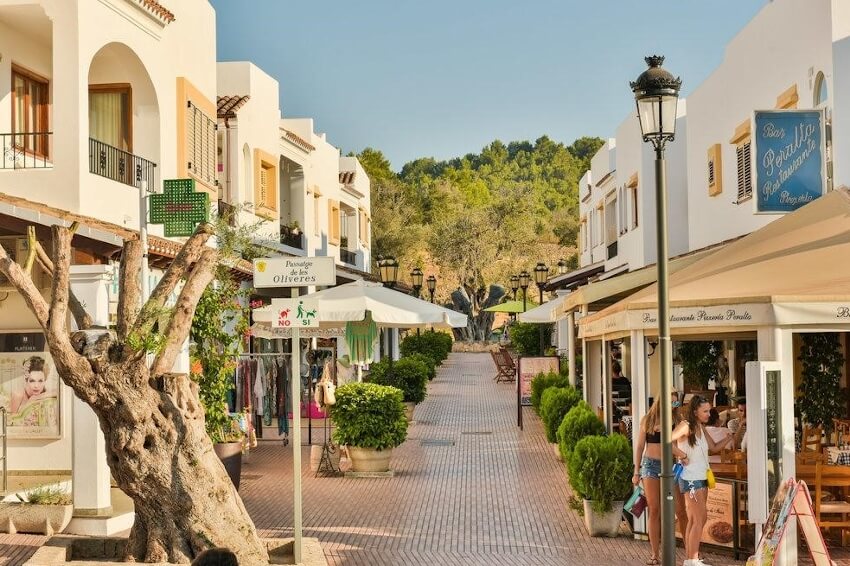
Source: ibiza-spotlight.es
Location: See map
Highlights: Very active cultural life, concerts and exhibitions.
San Rafel de Sa Creu
Known as the pottery village, in the centre of the island, where the best potters of the island worked.

Sant Llorenç de Balafia
It is a small Ibiza village with a lot of history, surrounded by countryside and with hardly any houses. There you will find the well-known restaurant La Paloma, which serves homemade organic food in a beautiful garden.
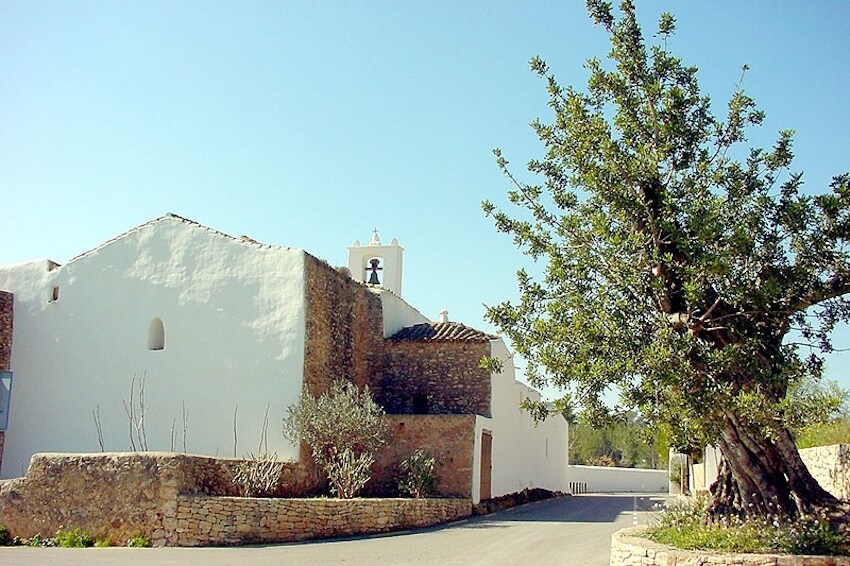
Source: ibiza5sentidos.es
Name: Sant Llorenç de Balafia
Location: See map
Highlights: “La Paloma” restaurant (organic food), it’s one of the first Ibiza villages.
Sant Josep de sa Talaia
It is the largest town in Ibiza and, although it has no beaches or museums to visit, on its main avenue you will find the Town Hall, some bars, small shops and a beautiful 18th century church that is very characteristic of traditional Ibizan architecture.
The fiestas of San José are famous amongst the locals for the flower power party that fills the town with hippy atmosphere and 80’s music.
It is worthwhile to climb up to Sa Talaia, the highest mountain in the Pitiusas at 475 metres, which can be reached on foot from the village. Although the route is uphill, the route does not require great physical fitness and the panoramic views from the top compensate for the effort.
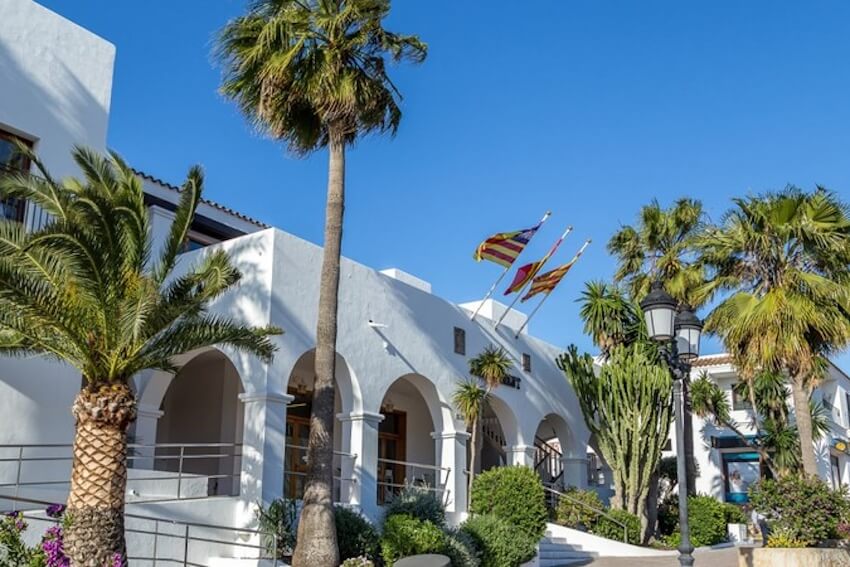
Source: visit.today
Name: Sant Josep de sa Talaia
Location: See map
Highlights:“Flower power party” and the highest mountain of the Pitiusas, Sa Talaia.
Santa Gertrudis de Fruitera
A charming Ibiza village in the interior of the island, with its white houses and typical Mediterranean surroundings. It is one of the best preserved villages aesthetically where you can stop for a drink or simply stroll through its narrow streets.
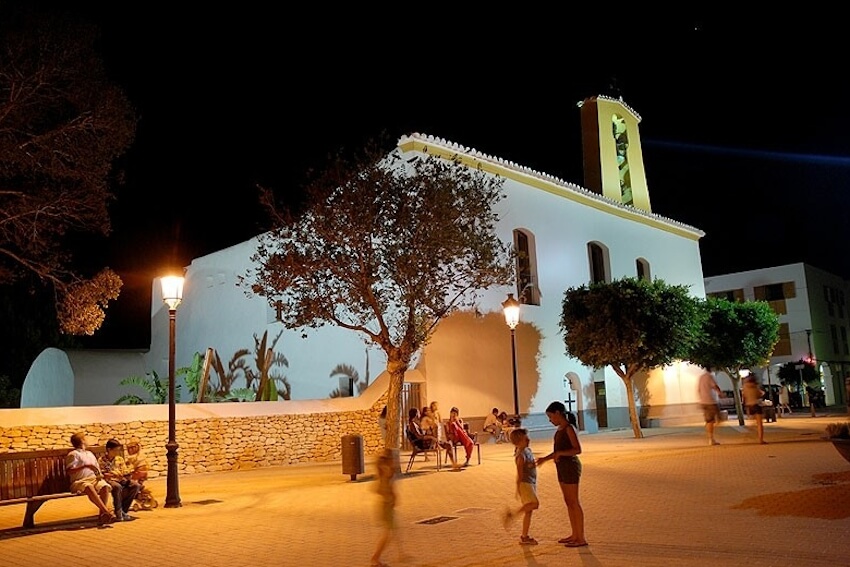
Source: ibiza5sentidos.es
Location: See map
Highlights: Ibiza’s best-preserved original village.
Santa Agnès de Corona
The most characteristic feature of the area is Pla de Corona, a flat expanse of red earth full of almond trees that is a wonderful sight in January and February, when the almond blossoms fill the area with their pink and white flowers.
From Santa Agnès de Corona you can visit the tiny village of Forada, in Buscastell, a crossroads where you will find its tiny church in the middle of the Ibizan countryside.
This Ibiza village shows the essence of the original villages of the island of Ibiza.

Source: espanaviajar.com
Location: See map
Highlights: Almond blossom fields in January-February.
Sant Jordi de Ses Salines
It is the urban area closest to the airport where you can find shops that basically serve as a supply for people passing through the airport.
Close to the village area is the main natural park of the island, its extensive area stretching from the south of Ibiza to the north of Formentera, including the famous Playa de Las Salinas, a territory of almost 3,000 hectares of land and 13,000 hectares of sea, which was declared a natural park in 2001. It used to be a UNESCO World Heritage Site (since 1999).
The whole area is of enormous natural beauty and ecological value. It offers an area of ponds, the largest wetland area of the island, where almost all year round you can see flamingos.
Las Salinas beach is one of the areas we visit on our week charter boat trips in the north of Ibiza that we organise for private groups throughout the year.

Source: espanaviajar.com
Location: See map
Highlights: Las Salinas beach and the largest natural park in Ibiza.
Sant Francesc de s’estany
The tiny coastal Ibiza village has little more than a few houses scattered around the countryside, although its main tourist attraction lies on the coast, on its quay where you can see the old salt extraction plant and the landscapes of the salt pans that surround it.

Source: espanaviajar.com
Location: See map
Highlights: Visit the old pier and the beautiful coastline.
La Salinera
Salt mining activity began on the island of Ibiza around 600 BC by the Phoenicians. It was one of Ibiza’s main exports and sources of wealth. Between the beaches of Es Cavallet, Las Salinas and Es Codolar you can still see the salt ponds. At the end of Salinas beach you will see the remains of a 19th-century railway that was used to transport salt to the Sa Canal quay, from where it travelled all over the world. The salt industry is still alive and well on the island.

Source: estorrent.net
Location: See map
Highlighst: Salt marshes on the beaches of Es Cavallet, Las Salinas and Es Codobar.
Santa Eulària des Riu
It is a tourist centre, mostly family-oriented but very busy, where you will find an extensive coastal promenade, beautiful beaches, good restaurants, street markets and tradition.
Arriving in Santa Eulalia from Ibiza you can see the beautiful hill that rises high above the area, the Puig de Missa, a 16th century fortified church with a cemetery, gardens and wonderful views of the sea and the town. The Santa Eulalia River is the only river in the Balearic Islands, and although its flow is practically dry, it offers a pleasant walk to its mouth at the beach.

Source: maximo_crk
Location: See map
Highlights: Beach walk, beaches, good restaurants and street markets.
Sant Mateu d’Aubarca
This tiny village is made up of a few houses situated around a beautiful 18th century church with a nave with eight side chapels and a large 19th century porch, a peculiar bell tower and an earthen Stations of the Cross outside the church.
The most interesting things to see in this area of great agricultural and winemaking tradition are the nearby wineries, such as Bodega de Sa Cova and Bodega de Can Maymó, which offer guided tours with wine tasting and tasting of wines and local products.

Source: Wikipedia
Name: Sant Mateu d’Aubarca
Location: See map
Highlights: Wine cellars with visit and tasting and 18th century church.
Sant Antoni de Portmany
It was for thousands of years the main port of the island, hence its nickname in Ibicenco “de Portmany” which means “big port”. Its beautiful bay of calm, shallow waters is lined with bars, stores and restaurants and is lined with a lively promenade. Its location on the west of the island makes it an idyllic balcony for watching the sunset on a hot summer night. Of Ibiza’s villages, this is one of the prettiest partly because of its coastline. Years ago we decided that GOA Catamaran should have its main base here.

Source: ibizaspotlight
Location: See map
Highlights: Beautiful west facing bay, Sunset Ibiza.
Sant Miquel de Balansat
It is a village of modest dimensions with a characteristic church built on a hill that given its altitude allows you to enjoy beautiful views of the countryside.
A few kilometers to the northwest is Puerto de San Miguel, a sandy beach and natural harbor, where you can find some of the best fish restaurants on the island.
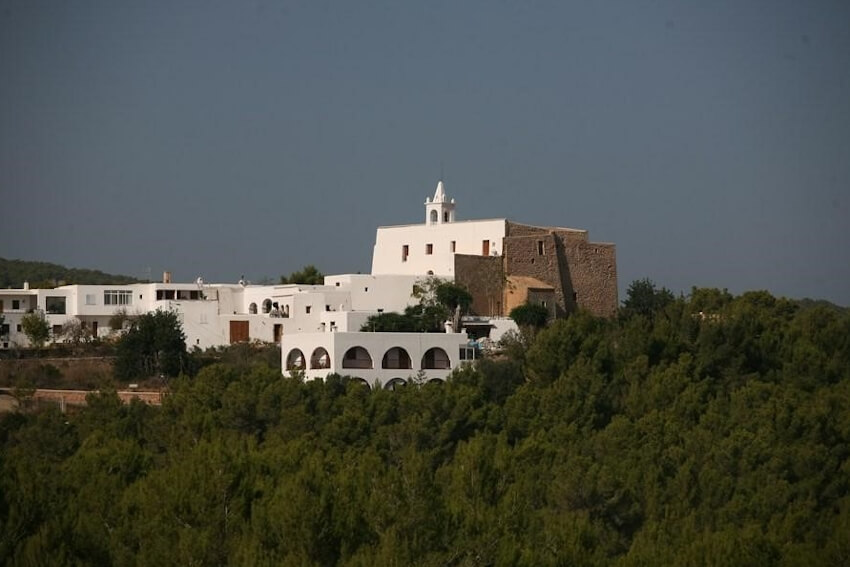
Name: Sant Miquel de Balansat
Location: See map
Hightlights: San Miguel’s port with excellent fish restaurants.
Would you like to visit some of the villages of Ibiza from a catamaran? Contact us and we will make you a personalized quotation for your group.


